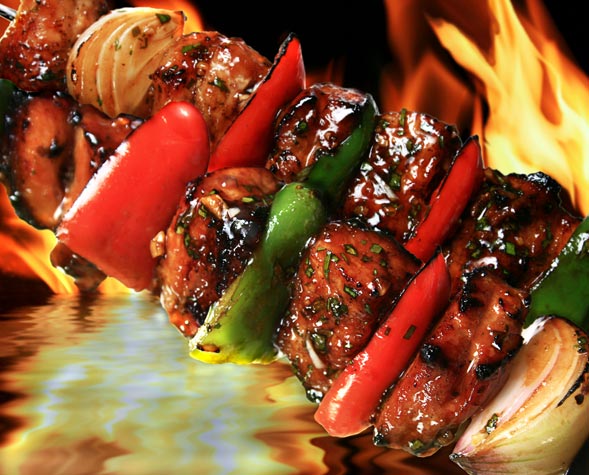Across cultures and around the globe, culinary masterpieces have been created that test the human limits of spiciness of foods.  Some raw and natural ingredients are incredibly spicy on their own, and sometimes chefs put together top spicy ingredients that are at their disposal. Once just a fun way to test the limits of taste buds, now cooking and sampling spicy cuisine – especially dangerously-hot spicy sauces – is a growing focus within self-identified food lovers.
Some raw and natural ingredients are incredibly spicy on their own, and sometimes chefs put together top spicy ingredients that are at their disposal. Once just a fun way to test the limits of taste buds, now cooking and sampling spicy cuisine – especially dangerously-hot spicy sauces – is a growing focus within self-identified food lovers.
Wilbur Scoville’s scale, connected to the Scoville Organoleptic Test, to rank and rate spiciness is still in use today around the world to benchmark the heat of different foods.
Ranking Spiciness: Measuring the heat with the Scoville Scale
For the average connoisseur of spicy foods, there isn’t much of a difference between hot and extra spicy. But ever since 1912 when Wilbur Scoville invented the Scoville scale, there has been an international obsession with ranking the spiciness of foods and competing to “conquer” all of the top foods. He developed the Scoville Organoleptic Test while at the Park Davis pharmaceutical company, and it is still in use today – ranging from the baseline spiciness of a sweet bell pepper to the 15,000,000 to 16,000,000 ranking of spiciness that is captured by pure capsaicin and Dihydrocapsaicin.
Surprisingly Non-Spicy Foods
Ever burned your tongue on some spicy food, to the point of crying or feeling itchy all over your body? Chances are, you haven’t even tried some of the most spicy foods out there. Pepperoncini, popular in Italian recipes as used by Nigellissima in her cooking books, only earns 300 – 500 points on the Scoville scale. A poblano pepper, known for making many eyes water in some of the most popular Mexican recipes, only earns about 1000 heat units on the Scoville Scale. For the average eater, there isn’t even the ability to handle the spiciness of salsas and peppers that score below 10,000 heat units on the Scoville scale – which include most tabasco sauces and peppers that are from spicy varieties. Often, even these “more mild” foods induce nausea, headaches, and rashes above that number.
Mongolian hot pots – also popular in China – are considered one of the spiciest meals to tackle, which will leave you sweating in a matter of minutes after your first bite. It’s signature mixture of onions, sichuan peppers, and garlic is a challenge for most tourists to handle. Don’t even think, though of comparing that dish to some of the more spicy foods that far surpass it on Scoville’s list.
Upping the Heat: The Spiciest Foods Out There
 If you really want to test your limits by eating spicy foods, Habanero peppers can score anywhere from 100,000 to 350,000 heat units, and are near on the list to Carolina Cayenne Peppers and Dave’s Insanity hot sauce. If you are travelling in the Carribean, try some Bahamian hot peppers, which score up to 110,000 on the scale. Dishes like Thai Pepper Steak – known as Neua Pad Prik, is a simple delicacy that sends many tourists into tears with it’s use of birds-eye chili peppers. Other spicy foods include the Spicy Horseradish Shrimp served at St. Elmo’s restaurant in Indiana, which can cause side effects that seem to mimic electrocution in the mouth!
If you really want to test your limits by eating spicy foods, Habanero peppers can score anywhere from 100,000 to 350,000 heat units, and are near on the list to Carolina Cayenne Peppers and Dave’s Insanity hot sauce. If you are travelling in the Carribean, try some Bahamian hot peppers, which score up to 110,000 on the scale. Dishes like Thai Pepper Steak – known as Neua Pad Prik, is a simple delicacy that sends many tourists into tears with it’s use of birds-eye chili peppers. Other spicy foods include the Spicy Horseradish Shrimp served at St. Elmo’s restaurant in Indiana, which can cause side effects that seem to mimic electrocution in the mouth!
Scoring in the category of tens of millions of Scoville heat units are specially engineered spicy sauces that approach the limits of pure capsaicin, the spiciest substance in the world which no other food can possibly exceed.
Blair’s sauces, made by Gardener Resources, probably have no place in your everyday cooking: police-grade pepper spray only scores 5,000,000 on the scale, and these souces score more than three times that amount.
Test your limits of foods listed high on the Scoville scale in small amounts, with plenty of starchy foods nearby to help conquer the adverse effects that might be brought about these foods. The best times to try these foods are while travelling, where you can test the limits of your pallet and keep many “hot and spicy” memories in mind long after your vacation – you’ll never forget the struggle to handle those Scoville-scale worthy foods!
“This is a post by Ashley Williamson, a part-time guest blogger and a full-time food lover. In her spare time she likes to travel and discover great dishes from around the world.”



